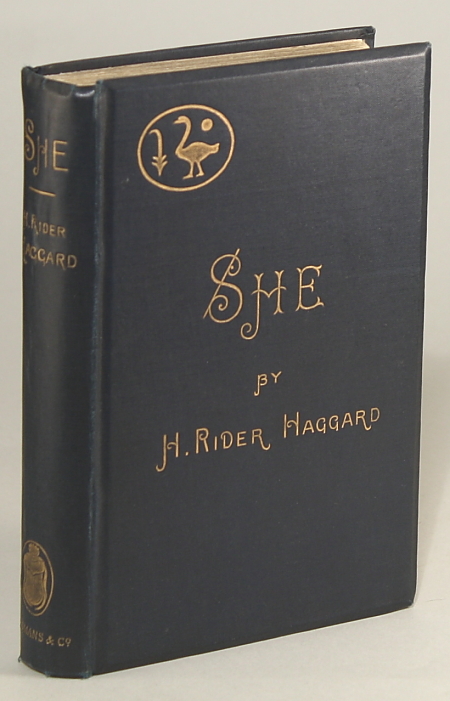Sir H. Rider Haggard (1856-1925) was born of a June 22.
As a young man, the well connected Haggard had served in a succession of administrative and diplomatic posts in British colonial South Africa in the late 1870s and early 1880s. The experience, seasoned with his vivid imagination, fueled a literary career that consisted of dozens of published articles as well as 77 books, the majority of which were romantic adventure novels set in far flung and remote locales, mostly Africa. Obviously, these books and their screen adaptations took the assumptions of colonialism as a given, and propagated now-outmoded notions about race.
Haggard’s third novel King Solomon’s Mines (1885) proved so popular that he wrote an additional thirteen novels and four short stories starring its hero, big game hunter and adventurer Allan Quatermain. These novels in turn inspired Edgar Rice Burroughs and other writers of pulp jungle stories that became the bases of B movies and serials with jungle settings (and lost cities therein). While there had been silent screen adaptations of King Solomon’s Mines and its sequel Allan Quatermain as early as 1919, a number of later incarnations are more notable. The chief ones are:
King Solomon’s Mines (1937) starring Cedric Hardwicke, with Paul Robeson as an African chieftain and British Bombshell Anna Lee as the love interest
King Solomon’s Mines (1950) with Stewart Granger as Quatermain, with Deborah Kerr
Watusi (1959) with George Montgomery
King Solomon’s Treasure (1979) with John Colicos as Quatermain, with an all-star cast that included David McCallum, Britt Ekland, Wilfrid Hyde-White, and Patrick Macnee, who replaced the already ailing Terry-Thomas.
King Solomon’s Mines (1985) and Allan Quatermain and the Lost City of Gold (1987) starred Richard Chamberlain and Sharon Stone. The films were a naked (and inferior) attempt to cash in on the popularity of the Indian Jones films…which of course were an homage to the kind of ’30s serials which had themselves been inspired by Haggard’s books.
There was also a 2004 TV mini-series based on King Solomon’s Mines starring Patrick Swayze.
Haggard’s fourth novel, She: A History of Adventure (1886) proved to be roughly as popular as its predecessor. This one posits the existence of a lost people in the jungle interior who worship a cruel and beautiful demi-god-like queen known as She-Who-Must-Be-Obeyed (a reference revived for humor in John Mortimer’s Rumpole of the Bailey books). Psychologists and critics have had a field day analyzing the significance of this dream-like tale, which literal places a female on a pedestal. Haggard penned three sequels to the original novel.
She was popularly adapted for the screen long before the Quatermain stories. There’s a version as early as Melies’s La Colonne de feu (The Pillar of Fire) in 1899. Actresses who have gotten to play the plum screen role of She have included Marguerite Snow (1911), Valeska Suratt (1917), Betty Blythe (1925), Helen Gahagan (1935; more on that version here), and Ursula Andress (1965).
A scattered handful of other Haggard novels were also adapted for the screen, the most notable of which, Cleopatra (1889) was one of the sources for the now-lost 1917 silent film starring Theda Bara.
Like Arthur Conan Doyle, Haggard was interested in spiritualism and Theosophy. He was a good friend of Rudyard Kipling’s, and a sometime collaborator of Andrew Lang.




You must be logged in to post a comment.